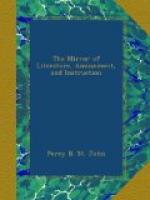Title: The Mirror of Literature, Amusement, and Instruction, No. 333 Vol. 12, Issue 333, September 27, 1828
Author: Various
Release Date: February 17, 2005 [EBook #15087]
Language: English
Character set encoding: ASCII
*** Start of this project gutenberg EBOOK the mirror of literature, ***
Produced by Jonathan Ingram, David Garcia and the
PG Online
Distributed Proofreading Team.
* * * * *
The mirror of literature, amusement, and instruction.
Vol. XII, no. 333.] Saturday, September 27, 1828. [Price 2d.
* * * * *
FIRE TOWER
[Illustration: Fire tower]
Throughout Scotland and Ireland there are scattered great numbers of round towers, which have puzzled all antiquarians. They have of late obtained the general name of Fire Towers, and our engraving represents the view of one of them, at Brechin, in Scotland. It consists of sixty regular courses of hewn stone, of a brighter colour than the adjoining church. It is 85 feet high to the cornice, whence rises a low, spiral-pointed roof of stone, with three or four windows, and on the top a vane, making 15 feet more, in all 100 feet from the ground, and measuring 48 feet in external circumference.
Many of these towers in Ireland vary from 35 to 100 feet. One at Ardmore has fasciae at the several stories, which all the rest both in Ireland and Scotland, seem to want, as well as stairs, having only abutments, whereon to rest timbers and ladders. Some have windows regularly disposed, others only at the top. Their situation with respect to the churches also varies. Some in Ireland stand 25 to 125 feet from the west end of the church. The tower at Brechin is included in the S.W. angle of the ancient cathedral, to which it communicates by a door.
There have been numerous discussions respecting the purposes for which these towers were built; they are generally adjoining to churches, whence they seem to be of a religious nature. Mr. Vallencey considers it as a settled point, that they were an appendage to the Druidical religion, and were, in fact, towers for the preservation of the sacred fire[1] of the Druids or Magi. To this Mr. Gough, in his description of Brechin Tower,[2] raises an insuperable objection. But they are certainly not belfries; and as no more probable conjecture has been made on their original purpose, they are still known as Fire Towers.
For this curious relic we are indebted to Mr. Godfrey Higgins’s erudite quarto, entitled “The Celtic Druids,” already alluded to at page 121 of our present volume.




